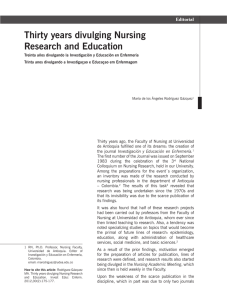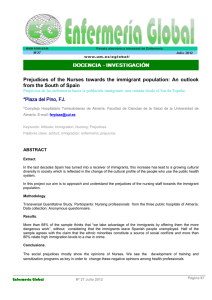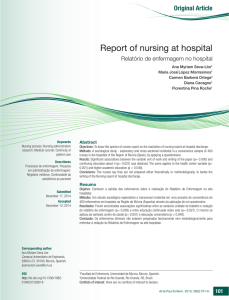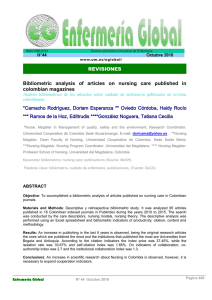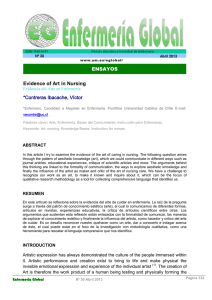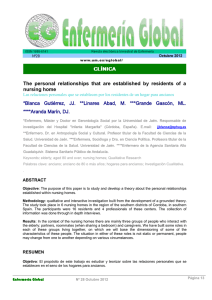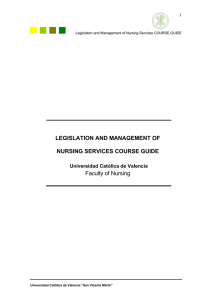Stress perception in Nursing students facing their clinical practices
Anuncio
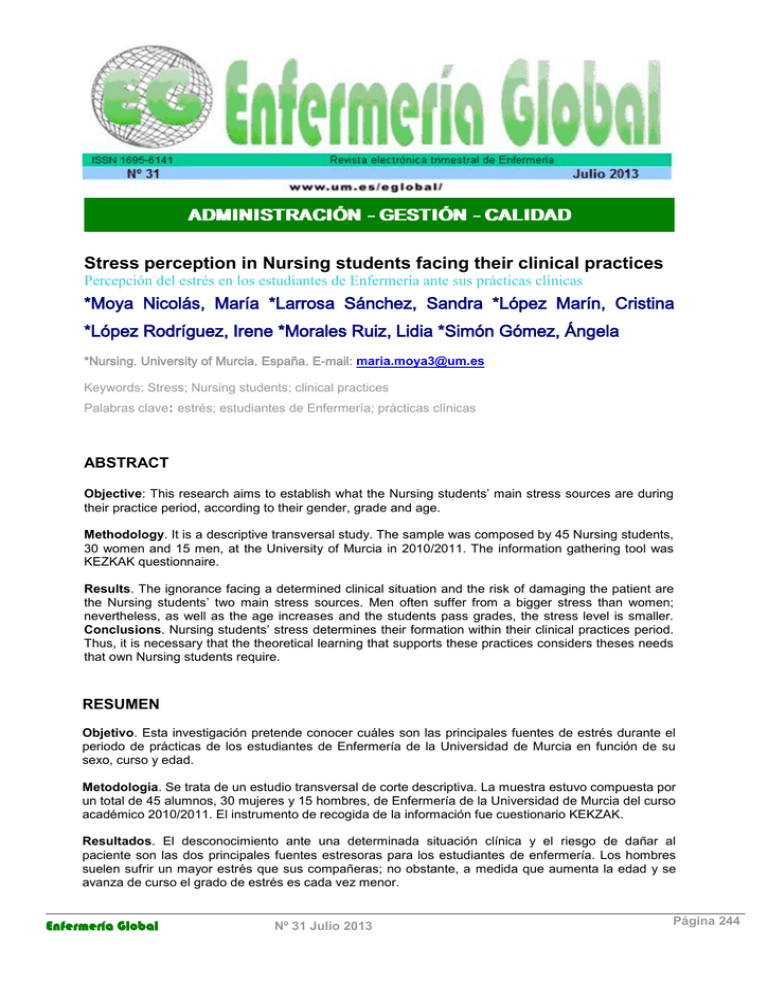
ADMINISTRACIÓN - GESTIÓN - CALIDAD Stress perception in Nursing students facing their clinical practices Percepción del estrés en los estudiantes de Enfermería ante sus prácticas clínicas *Moya Nicolás, María *Larrosa Sánchez, Sandra *López Marín, Cristina *López Rodríguez, Irene *Morales Ruiz, Lidia *Simón Gómez, Ángela *Nursing. University of Murcia. España. E-mail: maria.moya3@um.es Keywords: Stress; Nursing students; clinical practices Palabras clave: estrés; estudiantes de Enfermería; prácticas clínicas ABSTRACT Objective: This research aims to establish what the Nursing students’ main stress sources are during their practice period, according to their gender, grade and age. Methodology. It is a descriptive transversal study. The sample was composed by 45 Nursing students, 30 women and 15 men, at the University of Murcia in 2010/2011. The information gathering tool was KEZKAK questionnaire. Results. The ignorance facing a determined clinical situation and the risk of damaging the patient are the Nursing students’ two main stress sources. Men often suffer from a bigger stress than women; nevertheless, as well as the age increases and the students pass grades, the stress level is smaller. Conclusions. Nursing students’ stress determines their formation within their clinical practices period. Thus, it is necessary that the theoretical learning that supports these practices considers theses needs that own Nursing students require. RESUMEN Objetivo. Esta investigación pretende conocer cuáles son las principales fuentes de estrés durante el periodo de prácticas de los estudiantes de Enfermería de la Universidad de Murcia en función de su sexo, curso y edad. Metodología. Se trata de un estudio transversal de corte descriptiva. La muestra estuvo compuesta por un total de 45 alumnos, 30 mujeres y 15 hombres, de Enfermería de la Universidad de Murcia del curso académico 2010/2011. El instrumento de recogida de la información fue cuestionario KEKZAK. Resultados. El desconocimiento ante una determinada situación clínica y el riesgo de dañar al paciente son las dos principales fuentes estresoras para los estudiantes de enfermería. Los hombres suelen sufrir un mayor estrés que sus compañeras; no obstante, a medida que aumenta la edad y se avanza de curso el grado de estrés es cada vez menor. Enfermería Global Nº 31 Julio 2013 Página 244 Conclusiones. El estrés de los estudiantes de enfermería marca su formación durante el período de prácticas clínicas. Por tanto, se hace necesario que el aprendizaje teórico que sustenta a las prácticas atienda a estas necesidades que los propios estudiantes de enfermería demandan. INTRODUCTION Through his whole life, a human being aims to adapt himself to the changes he lives, looking for the balance between his organism and his environment, what origins an answer to stress, necessary to face new experiences (1, 2, 3). Nowadays, stress and its study have reached high popularity in quotidian language and in scientific literature as well, being considered as a predisposing, triggering or contributing factor to the development of multiple illnesses which can be serious (4). The concept of stress was firstly coined by the physiologist Hans Selye, who defined it as “an organism reaction to environment requirements” in 1950 (5). Since 1950, stress has been conceptualised in several ways, as a reaction, a stimulus or a process(5,6). Thus, Holmes and Rahes(7) understand stress as: “an independent variable stimulus or load produced in organism, creating discomfort, in such a way that whether tolerance limits are surpassed, stress becomes insufferable, appearing then psychological and physical problems”. On the other side, Lazarus and Folkman, from a stress perspective as a process, define it as: “a transitory relationship between one person and his environment which is assessed as threatening and able to overtake his resources and to endanger his wellness and homeostasis”; producing a dynamic interaction between two basic processes: the cognizable valuation that each person does about his environment requirement and the facing strategies he has to face those requirements (8). At present, stress is considered as the result of individual incapability to face environment requirements, unlike anxiety that is emotional response to a threaten expressed in cognitive, physiologic, motor and emotional areas (9). Therefore, anxiety is the principal emotional response to stress, considered a transitory condition, characterised by tension subjective feelings, apprehension, restlessness and worry as well as a hyperactivity of central nervous system, which can vary its intensity and last(10). Through their whole life, everybody has experienced some of the negative stress consequences. In this way, analogously, through academic life, students and, specifically those who carry out practises in hospitals as nursing students do, are exposed to stress(11). Additionally, it must be assumed that “what is considered as stressing by one person cannot be considered as stressing by other person”, therefore stress is different for each student. Consequently, this fact forces students to, in an attempt of adapting to these situations, develop a sort of facing strategies to success the requirements, looking for the relieve of their tension state. Nevertheless, a large percentage of university students lack the needed strategies or adopt inadequate strategies(12). Clinical practises are a key element in nursing students’ formation because they let them apply their theoretic knowledge and develop skills for providing care to their Enfermería Global Nº 31 Julio 2013 Página 245 patients(13). Hospital practises have a deep educative impact to the extent that the knowledge acquired during them let the abilities and personal attitudes development which is necessary to the acquisition of competences that let them incorporate to healthcare system like professionals(14). Within their clinical practises, students have their first contact with their future profession and have a small training on it, facing difficult situations, which often produce stress and not always does the environment where they take place foster the whole understanding of nursing practise(10). Healthcare systems usually provide many stimulus that produce stress due to the contact with illnesses, pain, suffering, disability, patients death, the need of establishing relationships with several sanitary professionals and patients, as well as the fact of developing a new role which they are not completely prepared for (15). Diverse studies have described the main stress sources in nursing students, linking them to clinical, academic, social and interpersonal areas(16). Zryewsky and Davis demonstrated that academic and clinical area supposed a 78,4% of stressing occurrences, meanwhile social and interpersonal areas supposed a 8% and a 13,6% respectively(17). Among the most intense situations experienced by nursing students within their clinical practises they remark: a patient death, suffering, contact with terminally ill and facing death, critical pathologies situations, cardio-respiratory stoppage, relationship with patients and their families and the difference between theoretic knowledge and practical requirements(13). Timmins and Kaliszer have observed that the main stress sources during the last year of nursing degree are: academic stress, relationships with professors, relationships in their clinical practise and patients death (18, 19). Therefore, in the formation of nursing students, determining which are the main stress sources is fundamental in order to know which skills must be mastered and, in this way, contributing to the health of future sanitary professionals and, indirectly, to a better care of ill patients(9). According to the literature gathered, there was not any questionnaire until 2003, neither in Spanish nor in English to assess stress sources within nursing students practises(18). Consequently, our research aims to determine which the main nursing students’ stress sources are, as well as their evolution through nursing degree and, specifically, measuring stress sources in function of their age, gender and grade. Furthermore, it is interesting to determine the evolution of those stress sources as students are being taught and are acquiring experience in order to prevent stressing situations. Nursing job produces stress because of the own job and organisation aspects(20). METHODOLOGY The sample was made up by 45 students (15 men and 30 women) whose ages vary from 17 to 24 years old (M = 19,67; SD = 1,85) enrolled at Nursing Degree of University of Murcia in 2011. There were 16 first year students, 15 second year students and 14 third year students. Sociodemographical variables considered were gender (men or women), enrolled year (first, second or third) and age. The sampling Enfermería Global Nº 31 Julio 2013 Página 246 method was non-probabilistic by convenience including only those students who voluntarily wanted to participate. It is a transversal and descriptive study whose instrument is KEZKAK questionnaire, which assess those factors that can produce stress in nursing students and have a high fiability and validity levels. It has 12 items that must be answered in a Likert scale of 5 values that covers from (1) “not at all stressful to (5) “absolutely stresful”. Data analysis was done using SPSS 20. Statistic significance was considered for those values whose probability was lower than p = ,050. RESULTS Descriptive data about the whole simple for all the stressing variables considered are presented below, in Table 1. Mean Standard Desviation Handling New Technologies 3,49 1,24 Ignorance facing Clinical Situations 4,51 ,92 Contact with Others’ Suffering 3,62 1,21 Relationships with other Healthcare Professionals 3,73 1,36 Impotency and Uncertainty facing Situations 4,40 ,84 Cannot Control Relationship with Patients 2,67 1,35 Emotional implications with ill persons 4,02 1,32 Risk of Contagion, Damage or Injuries 4,27 1,12 Risk of Damaging the Patient 4,51 ,82 Relationships with Patient Family 2,29 1,42 Excess – Overload of Work 4,16 ,98 Practise Evaluation Results 3,58 1,08 Table 1. Descriptive data of stressing sources. It is shown that the main situations that produce stress are the ignorance facing clinical situations, the impotency and uncertainty facing them and the risk of damaging the patient. These three variables are related with formation quality, specifically practical formation which seems to be inadequate or, at least, that is what nursing students think. On the other side, social relationship with the patient as with his family are the less powerful sources among the studied stressing sources. Next, the relationship between gender and academic year with each one of the stress source is presented below. To do that, normality distribution analysis has been done through χ2 test resulting a non-parametric distribution for gender and parametric Enfermería Global Nº 31 Julio 2013 Página 247 distribution for academic year. Therefore, correlation between gender and the source of Stress has been studied through U Mann Whitney test reaching statistic significance in 4 of the 12 stressing sources. Significance and values of these relationships are shown in Table 2. Source of Stress Handling New Technologies Ignorance facing Clinical Situations Contact with Others’ Suffering Relationships with other Healthcare Professionals Impotency and Uncertainty facing Situations Cannot Control Relationship with Patients Emotional implications with ill persons Risk of Contagion, Damage or Injuries Risk of Damaging the Patient Relationships with Patient Family Excess – Overload of Work Practise Evaluation Results Gender Sig. Men Women 4,33 ± 0,82 3,07 ± 1,22 ,001 4,33 ± 0,98 4,60 ± 0,89 ,245 4,53 ± 0,64 3,17 ± 1,18 ,000 3,80 ± 1,42 3,70 ± 1,34 ,753 4,53 ± 0,52 4,33 ± 0,96 ,860 3,80 ± 1,01 2,10 ± 1,13 ,000 4,27 ± 0,96 3,90 ± 1,47 ,559 4,40 ± 0,83 4,20 ± 1,24 ,901 4,60 ± 0,63 4,47 ± 0,90 ,776 2,40 ± 1,50 2,23 ± 1,41 ,749 4,33 ± 0,90 4,07 ± 1,02 ,379 4,20 ± 1,01 3,27 ± 0,98 ,007 Table 2. Correlation between gender and source of stress. In this way, the higher stress experienced by men in handling new technologies, contact with others’ suffering, cannot control relationships with patients and practise evaluation results is demonstrated. To carry through the study of the link between stressful situations and academic year, ANOVA test has been done, whose results are shown below, in Table 3. Handling New Technologies Ignorance facing Clinical Situations Contact with Others’ Suffering Inter-groups Squares sum 22,378 df 2 Square Mean 11,189 Intra-groups 44,866 42 1,068 Total 67,244 44 1,347 2 ,673 Intra-groups 35,898 42 ,855 Total 37,244 44 19,644 2 9,822 44,933 42 1,070 64,578 44 Inter-groups Inter-groups Intra-groups Total Enfermería Global Nº 31 Julio 2013 F 10,474 Sig. ,000 ,788 ,461 9,181 ,000 Página 248 Relationships with other Healthcare Professionals Impotency and Uncertainty facing Situations Cannot Control Relationship with Patients Emotional implications with ill persons Risk of Contagion, Damage or Injuries Risk of Damaging the Patient Relationships with Patient Family Excess – Overload of Work Practise Evaluation Results Inter-groups 1,272 2 ,636 Intra-groups 79,528 42 1,894 Total 80,800 44 2,652 2 1,326 Intra-groups 28,148 42 ,670 Total 30,800 44 23,810 2 11,905 Intra-groups 56,190 42 1,338 Total 80,000 44 14,283 2 7,142 Intra-groups 62,695 42 1,493 Total 76,978 44 3,760 2 1,880 Intra-groups 51,040 42 1,215 Total 54,800 44 Inter-groups 1,216 2 ,608 Intra-groups 28,028 42 ,667 Total 29,244 44 Inter-groups Inter-groups Inter-groups Inter-groups Inter-groups ,193 2 ,096 Intra-groups 89,052 42 2,120 Total 89,244 44 Inter-groups 2,859 2 1,430 Intra-groups 39,052 42 ,930 Total 41,911 44 Inter-groups 11,330 2 5,665 Intra-groups 39,648 42 ,944 Total 50,978 44 ,336 ,717 1,979 ,151 8,898 ,001 4,784 ,013 1,547 ,225 ,911 ,410 ,045 ,956 1,538 ,227 6,001 ,005 Table 3. Correlation between academic year and source of stress. According to shown data, significant differences can be observed for 5 sources of stress: handling new technologies, contact with others’ suffering, cannot control relationships with patients, emotional implications with him and practise qualification. These variables evolution is shown in Figure 1. 6 5 4 Primero 3 Segundo 2 Tercero 1 0 Handling New Technologies Contact with Others' Suffering Cannot Control Relationships with Patients Emotional Implications with ill Persons Practise Evaluation Results Figure 1. Evolution of stress source with significant changes. It can be observed that with regards to these 4 stressful situations, the level of stress decreases as the students progress trough the academic years. Enfermería Global Nº 31 Julio 2013 Página 249 Finally, with respect to participants’ age, Kolmogorov-Smirnov test has been done, achieving a non-parametric distribution; therefore, its bivariate study with each one of stress sources has been done through Pearson Correlation Test. Since higher academic year students are usually older than lower academic year students, significant statistic with the same direction (lower as the age increases) has been found in stress sources in function of age test, that is: handling new technologies (r = -,365 p = ,014), contact with others’ suffering (r = -,352 p = ,018), cannot control relationships with patients (r = -,511 p = ,000), emotional implications with ill persons (r = -,313 p = ,036) and qualification worry (r = -,313 p = ,037). DISCUSSION Mean values on the whole simply show a high perception of stress within the clinical practises. It agrees with other studies that find higher stress levels in nursing students when they were putting in practice their theoretic knowledge. It should be outlined that these values report about what situation they think that is more stressing but not about stress level (13). It is remarkable that several situations included in the questionnaire were considered as quite or very stresful. In line with other studies, the main stresful situations have been “ignorance facing clinical situations”(11) and “impotency and uncertainty facing situations”(8); nonetheless this study adds “risk of damaging the patient”(8) which is not considered in other researches as an important stress element for nursing students. On the other side, other studies mark the situations related to relationships with professionals, partners, patients and practice professors as the main stressing sources(4) but, otherwise, in this study these factors are the least stressful sources. With respect to stres factors, it can be considered that stressful situations that students live with a higher intensity are caused by the insecurity of facing new situations and the fear of ignore the correct answer, above a characteristic of their attitudes. The fact of being a population in formation who still has not acquired enough skills and security to provide healthcare can explain that the fear of doing an incorrect work or damaging the patient, inject an infected needle or being contagious by the patient are the more stressing situations for nursing students, in line with other studies(24). Despite some differences being found among the participants of their stress sources according to their gender, the number of men who made up the sample was low thus, those differences have to be understood under this fact. Nonetheless, it can be affirmed that men feel more stressed than women, which does not concur with the results gathered by Amat, et al. (25) who demonstrated that, at the beginning of their clinical practises, men can feel a higher cognitive reaction but this feeling disappear as the practices develop. The higher stress perception among first year students in comparison with their fellow second and third year students must be outlined, although these differences are not important in all the stress sources. This could be explained by the lack of contact with patients that the first year students have because they have not already done their clinical practices(20, 22). On the other side, third year students have a reduced stress perception compared to first and second year students. In third year, the students have more practical experience what provides them a more intense feeling of selfconfidence and, furthermore, they have more knowledge so it diminish their worry in Enfermería Global Nº 31 Julio 2013 Página 250 items about “I face a situation where I do not know what to do”, “I face an urgent situation” or “I receive contradictory orders” as López-Medina and Sánchez-Collado demonstrated (13). The same as in Ferrer Pascual et al. research(15), a small diminution in stress perception as the age of nursing students increases has been found but, different from that research “contact with others’ suffering” and “practice evaluation results” have kept steady. CONCLUSION Individual controlled characteristics of participants were: gender, age, academic year and stress sources. The most of the studied population presents high stress levels; being the most important stress source the “ignorance facing a clinical situation”. Among their first contacts with nursing profession (first year students) they are afraid of damaging either the patient or theirselves. On the contrary, they do not feel stress because of the relationships with other students, healthcare professionals, professors or patients; perhaps because it does not endanger their health or patient health and they feel more prepared to social relationships than to face the previous situations. Stress level is significantly related to the use of strategies focused on the problem; however, the use of emotion is also related to higher stress levels. Therefore, acquiring techniques and therapies orientated to stress facing and diminution is able to produce a significant change on students. Then, it is important to do track longitudinal study to those students who will keep on studying during 2011 – 2012 academic year, in order to check whether the perception levels of stressing situations maintain steady or diminish throughout that academic year. Given the transcendence of the detected stress in nursing students, it is necessary to implement formation programs to encourage facing strategies to stress. These programs could be very useful to help the future healthcare professionals to identify their stress situations, to diminish their stress perception and to enjoy their daily work without risk for their health. Putting in order from higher to lower stress situations can help to prioritize and to plan the educative interventions to the extent that it lets know in detail what experiences lived during their clinical practices influence them more and which are perceived with a higher intensity. This will ease that future nursing professionals are able to adaptively react to their daily stress stimulus in their work environment. For professors, it is important that, when they teach their students, they try to adapt their contents to real situations because being excessively separated from real situations does not ease the learning. It is also important that the current healthcare professionals do not forget that the students who are doing their clinical practice are still learning, that everybody lived that period and that the most important aim during this period is to learn, although each person has his own learning speed. Enfermería Global Nº 31 Julio 2013 Página 251 REFERENCES 1. Smeltzer SC, Bare BG, Sholtis Brunner L, Smith Suddarth D. Manual de Enfermería Médico Quirúrgico. Estrés y Adaptación 8ª Edición. México: Interamericana; 1998. 2. Papalia DE, Wendkos Olds S. Psicología. España: Mc Graw–Hill; 1995. 3. Mainieri R. Perspectiva cognitiva del estrés. J Soc Psychol 2008; 133 (2): 160-178. 4. Ticona Benavente BS, Paucar Quispe G, Llerena Callata G. Nivel de estrés y estrategias de afrontamiento en estudiantes de la Facultad de Enfermería – UNAS Arequipa. Enfermería Global 2006; 9 (19): 1-18. 5. Bruno Selye H. Tensión sin angustia. Madrid: Guadarrama; 1975. 6. Cobo Cuenca AI, Carbonell Gómez de Zamora R, Rodríguez Aguilera C, Vivo Ortega I, Castellanos Rainero RM, Sánchez Donaire A. Estresares y ansiedad de los estudiantes de enfermería en sus primeras prácticas clínicas. NURE Inv [Revista en Internet] 2010 [07/03/2011]; 7(49): 1-13. Disponible en: http://www.fuden.es/FICHEROS_ADMINISTRADOR/INV_NURE/NURE49_proyecto_e stresoresp.pdf 7. Holmes TH, Rahe RH. The social readjustment ratings scale. J Psychosom Res 1967; 11: 213-218. 8. Lázarus R, Folkman S. Estrés y procesos cognitivos. Barcelona: Martínez Roca; 1986. 9. Cano Vindel, A. Estrés laboral: la naturaleza del estrés. Sociedad española para el estudio del estrés 2002. Disponible en URL: http://www.ucm.es/info/seas/estrés_lab/estrés.htm 10. Miguel Tobal, JJ. La ansiedad. Madrid: Santillana; 1996. 11. Pades Jiménez A, Homar Amengual C. El estrés de los estudiantes en las prácticas clínicas de enfermería. Rev Rol Enferm [Revista Electrónica] 2006 [27/02/2011]; 29 (9): 19-24. Disponible en URL: http://dialnet.unirioja.es/servlet/articulo?codigo=2107901 12. Rodríguez Ramsbott GM. Efectos de un plan de técnicas de estudio en los estudiantes del primer semestre de la escuela de Enfermería [Tesis Doctoral]. Barquisimeto: Universidad Centro occidental Lisandro Alvarado, Decanato de Medicina; 1997. 13. López Medina I Mª, Sánchez Criado V. Percepción del estrés en estudiantes de enfermería en las prácticas clínicas. Enferm Clínica [Revista Electrónica] 2005 [14/0202011]; 15 (6): 307-313. Disponible en URL: http://www.elsevier.es/es/revistas/enfermeria-clinica-35/percepcion-estresestudiantes-enfermeria-las-practicas-clinicas-13082986-originales-2005 14. Juanola Pagés MªD, Blanco Sánchez R, Cónsul Giribet M, Zapico Yáñez, F. Aprendizaje y satisfacción de los estudiantes de enfermería en las prácticas clínicas (II). Atención Primaria de Salud. Enferm Clín. 1998; 7 (1): 16-24. 15. Ferrer Pascual MªA, Rojo Pascual MªC, Ruiz Gómez MªC, Fernández Araque AM, San Millán MG, Martínez León, JC. Análisis situacional de las prácticas clínicas en la Escuela de Enfermería de Soria. Metas Enferm. 2002; 5 (44): 18-22. 16. Sánchez M. Estrés de los estudiantes de enfermería en las prácticas clínicas. Enferm Cient. 1992; 127:43-46. Enfermería Global Nº 31 Julio 2013 Página 252 17. Zryewskyj T, Davis L. Sources of stress in third year baccalaureate nursing students. AARN-New-Lett. 1987; 43: 24-5 18. Zupiria Gorostidi X, Uranga Iturrioz MªJ, Alberdi Erize MJ, Barandiaran Lasa M. KEZKAK: Cuestionario bilingüe de estresores de los estudiantes de enfermería en las prácticas clínicas. Gac Sanit. 2003; 17 (1): 37-50 19. Timmins F, Kaliszer M. Aspects of nurse education programmes that frequently cause stress to nursing students- fact-finding sample survey. Nurse Educ Today. 2002; 22: 203-211. 20. Zupiria Gorostidi X, Uranga Iturrioz MªJ, Alberdi Erize MJ, Barandiaran Lasa M, Huitzi Egileor X, Sanz Cascante X. Fuentes de estrés en la práctica clínica de los estudiantes de enfermería: evolución a lo largo de la diplomatura. Enferm Clín. 2006;16 (5): 231-237. 21. Thomas JR, Nelson JK. Métodos de investigación en actividad física. Barcelona: Paidotribo; 2007. 22. Antolín Rodríguez R, Puialto Durán MJ, Moure Fernández ML, Quinteiro Antolín T. Situaciones en las prácticas clínicas que provocan estrés en los estudiantes de enfermería. Enfermería Global. 2007; 6 (1): 1-12. 23. López F, López MJ. Situaciones generadoras de estrés en los estudiantes de enfermería en las prácticas clínicas. Ciencia y Enferm. 2011; 2: 47-54. 24. Arribas Marín J. Toward a causal model of the dimensions of academic stress in nursing students. Rev Educ. 2011; (360): 533-556. 25. Amat Puig V, Fernández Gonzaga C, Orts Cortes I, Poveda Salva MR, Romá Ferri MT, Ribera Domene D. Estrés en estudiantes de enfermería. Rev ROL Enferm. 2008; 133: 75-80. ISSN 1695-6141 © COPYRIGHT Servicio de Publicaciones - Universidad de Murcia Enfermería Global Nº 31 Julio 2013 Página 253
